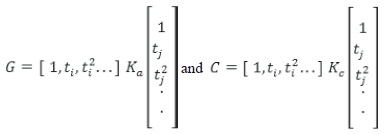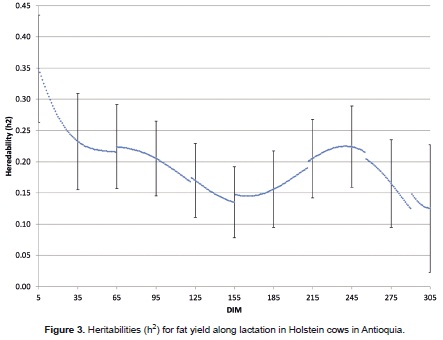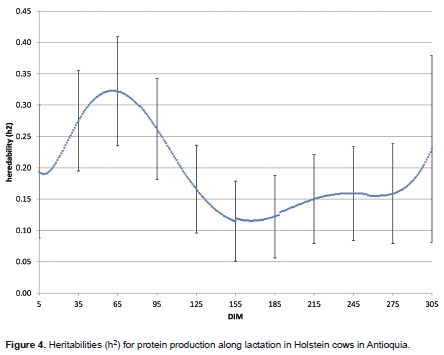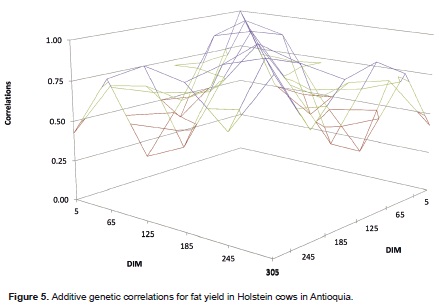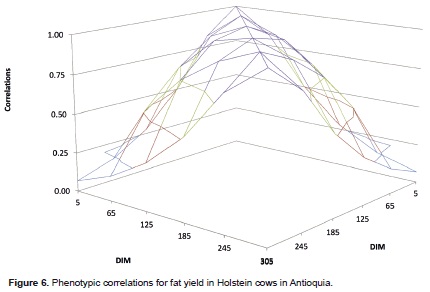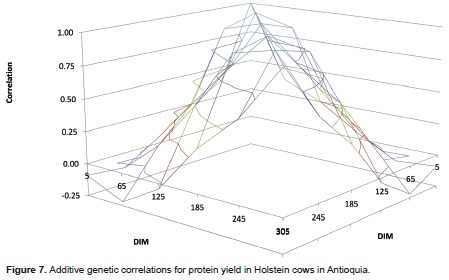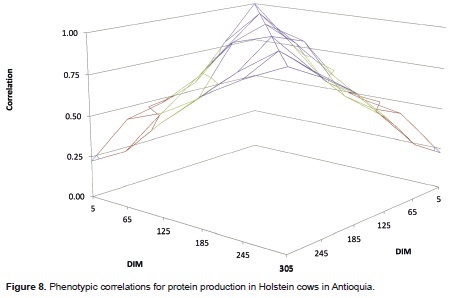Services on Demand
Journal
Article
Indicators
-
 Cited by SciELO
Cited by SciELO -
 Access statistics
Access statistics
Related links
-
 Cited by Google
Cited by Google -
 Similars in
SciELO
Similars in
SciELO -
 Similars in Google
Similars in Google
Share
Revista Colombiana de Ciencias Pecuarias
Print version ISSN 0120-0690
Rev Colom Cienc Pecua vol.27 no.4 Medellín Oct./Dec. 2014
ARTICLE
Variance and covariance components and genetic parameters for fat and protein yield of first-lactation Holstein cows using random regression models¤
Componentes de varianza y covarianza y parámetros genéticos para grasa y proteína láctea en vacas Holstein de primera lactancia mediante modelos de regresión aleatoria
Componentes de variância e covariância e parâmetros genéticos para gordura e proteína do leite em vacas da raça Holandesa de primeira lactação por meio de modelos de regressão aleatória
Oscar D Múnera Bedoya1*, Zoot, MSc; Ana C Herrera Ríos1, Zoot, MSc; Luis G González Herrera2, MVZ, MSc, PhD; Andrés F Henao Velásquez1, Zoot; Mario Cerón Muñoz1, Zoot, MSc, Dr.
1Grupo de Genética, Mejoramiento y Modelación Animal (GaMMA), Facultad de Ciencias Agrarias e Instituto de Biología, Universidad de Antioquia, Medellín Colombia.
2Facultad de Ciencias de la Salud, Universidad Tecnológica de Pereira. Current adress: Departamento de producción animal, Facultad de ciencias agrarias, Universidad Nacional de Colombia, Sede Medellín.
* Corresponding author: Oscar David Múnera Bedoya. Grupo de Investigación GaMMA, Facultad de Ciencias Agrarias, Universidad de Antioquia. Carrera 75 N° 65-87, Bloque 47-23 Ciudadela Robledo. AA1226, Medellín, Colombia. Tel (574) 2199140. Email: oscardmunera@gmail.com.
Received: January 14, 2014; accepted: June 24, 2014.
Summary
Background: the genetic parameters of the lactation curve in dairy cattle can be analyzed as longitudinal data using Random Regression Models (RRM). Objective: to estimate the (co) variance components and genetic parameters for fat (F) and protein (P) yield in first lactation Holstein cows of Antioquia (Colombia) by RRM based on Legendre polynomials. Methods: monthly F and P records (9,479) from 1,210 first-lactation Holstein cows were used. Twenty-two and 24 RRM were used for F and P, respectively, with different orthogonal Legendre-polynomial orders to estimate the fixed-curve population coefficients and predict direct-genetic additive and permanent environment effects. The models considered homogeneous and heterogeneous residual variances of 5, 7, and 10 classes. Results: the best fit for F was the fourth order model for the population fixed-curve and the additive genetic effect, and the third order for the permanent environment with seven heterogeneous variances. The best fit for P was the fifth order model for the population fixed-curve and the additive genetic and permanent environmental effects with five heterogeneous variances. The variance for the animals' genetic, phenotypic, permanent environment, and residual effects for both F and P decreased as lactation progressed. F and P heritabilities were between 0.13 and 0.38, and 0.12 and 0.32, respectively. Conclusion: first-birth animals can be selected in Antioquia for F and P characteristics. Selection should be done preferably at the beginning of lactation since they reach the highest heritability values at this time.
Keywords: genetic evaluation, heritability, milk quality, solids in milk.
Resumen
Antecedentes: los parámetros genéticos de la curva de lactancia en ganado de leche pueden ser analizados como datos longitudinales usando Modelos de Regresión Aleatoria (RRM). Objetivo: estimar mediante RRM basados en polinomios de Legendre componentes de (co) varianza y parámetros genéticos para producción de grasa (F) y proteína (P) láctea en vacas Holstein de primera lactancia de Antioquia (Colombia). Métodos: se incluyeron 9.479 registros mensuales de F y P pertenecientes a 1.210 vacas Holstein de primera lactancia. Para F y P se usaron 22 y 24 RRM respectivamente, con diferentes órdenes de polinomio ortogonal de Legendre para estimar los coeficientes de la curva fija de la población, la predicción de los efectos genético aditivo directo y del ambiente permanente. Los modelos consideraron varianzas residuales homogéneas y heterogéneas de 5, 7 y 10 clases. Resultados: para F, el mejor modelo fue el de cuarto orden para la curva fija de la población y el efecto genético aditivo, y de tercer orden para el ambiente permanente con siete varianzas heterogéneas. Para P, el modelo que presentó mejor ajuste fue el de quinto orden para la curva fija de la población, el efecto genético aditivo y el ambiente permanente y 5 varianzas heterogéneas. Para ambas características las varianzas genética aditiva directa, fenotípica, de ambiente permanente y residual disminuyeron a medida que avanzaba la lactancia. Las heredabilidades para F y P estuvieron entre 0,13 y 0,38, y entre 0,12 y 0,32, respectivamente. Conclusión: es posible realizar la selección para F y P en animales de primer parto en el departamento de Antioquia, preferiblemente al inicio de la lactancia, ya que ambas características presentan heredabilidades altas en esta etapa.
Palabras clave: calidad de leche, evaluación genética, heredabilidad, sólidos lácteos.
Resumo
Antecedentes: os parâmetros genéticos da produção de leite podem ser estimados usando Modelos de Regressão Aleatória (RRM). Objetivo: estimar por RRM com base em polinômios de Legendre os componentes de variância e covariância e os parâmetros genéticos para produção de gordura (F) e proteína (P) em vacas leiteiras de primeira lactação da raça holandesa em rebanhos de Antioquia, Colômbia. Métodos: foram avaliadas 9.479 registros mensais de F e P pertencentes a 1.210 vacas. Para F e P foram usados 22 e 24 RRM, respectivamente, com diferentes ordens de polinomiais ortogonais de Legendre para estimar os coeficientes da curva fixa da população, os efeitos genéticos aditivo direito, do ambiente permanente e residual. Os modelos consideraram variâncias residuais homogêneas e heterogêneas de 5, 7 e 10 classes. Resultados: para F, o melhor modelo foi o de quarta ordem para a curva fixa da população e o efeito genético aditivo, e de terceira ordem para o ambiente permanente com sete variâncias heterogêneas. Para P, o modelo que forneceu o melhor ajuste foi do quinto ordem para a curva fixa da população, o efeito genético aditivo e de ambiente permanente, e com 5 variâncias heterogêneas. Para ambas as características as variâncias genética aditiva direita, fenotípica e residual diminuíram no tempo. As herdabilidades para F e P ficaram entre 0,13 e 0,38 e entre 0,12 e 0,32, respectivamente. Conclusão: é possível fazer a seleção de animais da raça holandesa para F e P, de preferência no início da lactação, pois as duas características têm altas herdabilidades.
Palavras chave: avaliação genética, herdabilidade, qualidade do leite, sólidos lácteos.
Introduction
Genetic evaluation programs in dairy cattle have been directed towards increasing milk yields, which has led to greater genetic progress in Holstein cattle in developed countries by increasing annual milk yield by an average of 100 kg (Wiggans, 1997). Dairy production systems in the tropics have varying concentrations of metabolites in milk. The changes in fat (F) and protein (P) content are recognized as a response to the environmental and management conditions to which animals are exposed (Hernández and Ponce, 2006). In spite of this, the price of a liter of milk is determined based on F and P content (MADR, 2012).
The computational capacity achieved in recent years has allowed for the implementation of Random Regression Model (RRM) as an alternative to estimate genetic parameters and variance components in different points throughout lactation. Several authors have used RRM to develop genetic evaluations for milk production characteristics and modeling lactation curves. Fernández et al. (2011) estimated genetic parameters, covariance functions, and lactation curves in first lactation Holstein cows in Cuba through the application of orthogonal Legendre functions comparing different orders in 10 RRM. González- Peña et al. (2011) estimated values of heritability and genetic correlations between five measures of lactation persistence using RRM based on Legendre polynomial in first lactation Siboney cows in Cuba. Authors like Swalve (2000) have suggested the RRM for genetic evaluations of longitudinal data such as milk production, F, and P. Several studies have evaluated milk production traits in cattle and buffaloes in different locations and validated the application of the methodology as a model for developing genetic evaluations (Múnera et al., 2013; González-Peña et al., 2011; Herrera et al., 2012; Hurtado-Lugo et al., 2009; Hurtado-Lugo et al., 2006).
RRM allows the calculation of genetic values at any point on the milk production curve, in contrast to the multivariate models that only take into account the points where the characteristic has been measured (Espinoza-Villavicencio et al., 2011). The main practical implication of the RRM is the possibility to change the shape of the milk production curve through selection. In addition, characteristics evaluated on the test day can be used as early predictors of individual genetic merit (Jaffrézic and Minini, 2003).
The aim of this study was to estimate variance components and genetic parameters for F and P using RRM in first lactation Holstein cows in the province of Antioquia (Colombia).
Materials and methods
To estimate the genetic parameters, data from 30 dairy herds were used. Dairy herds were located near the northern and eastern portions of Antioquia where the municipalities of San Pedro de los Milagros, Entrerríos, Belmira, Bello, Rionegro, El Carmen de Viboral, and La Ceja are located. Herds participated in the dairy control program of the Corporación Holstein de Antioquia (Antioquia Holstein Corporation) and the Universidad de Antioquia. Dairy herds are situated in a wet, premountain forest life zone, with average temperatures of 16 °C, altitudes between 2,000 and 3,000 m, an annual rainfall between 2,000 and 4,000 mm, with topography ranging from flat to undulating. The forage base was mostly Kikuyu pasture (Pennisetum clandestinum) and some associations with Rye grass (Lolium perenne). Animals were supplemented with commercial feeds according to the productive stage and management criteria of each herd. The database included 9,479 monthly records of F and P belonging to 1,210 first lactation Holstein cows with births between November, 2007 and August, 2012. Milk control was conducted using the methodology A4 X2 (ICAR, 2002), which consisted in monthly visits and control at AM and PM milking. The database did not include information from animals with less than 4 controls during the lactation period or animals that had no production records before day 70. Contemporary groups were analyzed with at least 4 animals. The database included 4,951 animals in the relationship matrix.
To calculate genetic parameters of F and P yields, RRM were conducted with different orders of orthogonal Legendre polynomials to predict the coefficients of the population fixed-curve, the additive direct genetic effect, and the permanent environmental effect. Homogeneous and heterogeneous residual variances of 5, 7, and 10 classes were considered.
The random regression model used is represented in the following matrix form:
y= Xβ + Zα + Wc + e
Where:
y = is the vector of N observations for F and P.
β = vector of fixed effects of contemporary group (farm, year, calving season) and the regression coefficients of the population fixed-curve.
α = solution vector of the genetic additive random coefficients.
c = solution vector of the permanent environmental random coefficients.
X, Z, and W = incidence matrices of fixed, additive genetic, and permanent environment effects, respectively.
e = vector of independently distributed residuals, with homogeneity modeling of variance or heterogeneous modeling of variances classes.
Assuming that the model components presented expectations (E) and variances were:
Where:
Ka = the covariance matrix of the random regression coefficients of the additive genetic effect.
Kc = the covariance matrix of the random regression coefficients of the permanent environmental effect.
A= the additive genetic matrix.
INd = identity matrix of dimension.
Nd and R = diagonal matrix containing residual variances.
Days in milk (ti) and (tj) were standardized in the range -1 to 1. The genetic covariance (G) and permanent environmental (C) between days in milk were estimated by:
Parturition periods were defined in two groups, the first including the months from December to February and June to August, and the second from March to May and September to November, according to the rainfall in the area.
Variance components and genetic parameters of the model were obtained by the restricted maximum likelihood method using the statistical program REML WOMBAT developed by Meyer (2007).
Twenty-two and 24 models with Legendre polynomials were tested for F and P, respectively. F Models are comprised from 333.homountil to 554. het7 and P models are comprised from 333.homo to 555.het10. Different models were compared using the Bayesian information criterion BIC (Schwarz, 1978), which allows the comparison of non-nested models and castigate models with more parameters (Nunez- Anton and Zimmerman, 2000). Lower values of BIC mean a better model fit.
Where, p is the number of model parameters; N is the number of observations; logL is the natural logarithm of the maximum likelihood function; and r (X) is the range of the matrix X (incidence matrix for the fixed effects).
Results
According to the BIC criterion, the best model for F was the polynomial with order 4-4-3 for the fixed curve, the additive genetic, and the permanent environment effects with 7 heterogeneous variances (443.het7). The best model for P corresponded to the polynomial with order 5-5-5 for the fixed curve, the additive genetic, and the permanent environmental effects with 5 kinds of heterogeneous variances (555.het5).
For both characteristics F and P, it was found that the less-fitting adjustments, based on the BIC, corresponded to the less parameterized models and to those models that included homogeneous variances (333.hom and 433.hom). When the order of polynomials was increased in the present study, the difficulty for obtaining convergence was greater. It was impossible to reach convergence with the 555.het5 model for F, and with the 655.het5 model for P.
Estimated variances for F obtained with the 443. het7 model are shown in Figure 1. The variance for direct genetic, phenotypic, permanent environment, and residual effects showed the highest values at the beginning of the lactation period and decreased as the production period progressed. The direct genetic variance was between 0.002 kg2 and 0.016 kg2. The permanent environmental variance decreased from 0.015 kg2, in early lactation, to 0.009 kg2 at day 254, and ended with 0.013 kg2 at day 305.
Phenotypic variance values found were 0.017 kg2 for day 293 and 0.042 kg2 at the begining of lactation. The residual variance presented a similar behavior to the phenotypic variance, with values falling between 0.003 kg2 and 0.011 kg2.
The trajectory of the estimated variances for P is shown in Figure 2. The highest values for the direct genetic and phenotypic variances were around day 60, coinciding with the period of higher milk production. For the additive genetic variance, values were 0.002 kg2 for 149 to 205 days, and 0.007 kg2 for 45 to 85 days of lactation.
The highest values for the phenotypic variance were 0.023 kg2 from day 48 to 81, a period that corresponds to milk production peak and coincides with the highest level of supplementation of the studied population. As lactation progresses variances decreases, reaching 0.016 kg2 at day 290.
For the permanent environmental variance, the highest values (0.013 kg2) fell between days 137 and 167. The residual variance presented a downward trend as lactation progresses with values falling between 0.004 kg2 and 0.006 kg2.
For F heritability, the highest values were observed at the beginning of lactation, with 0.38 dropping to 0.14 at day 155. While lactation progressed, an increase to 0.23 in heratability was observed on day 239, which then declined again to the lowest value obtained (0.13 at day 305) (Figure 3).
Heritability for P ranged from 0.12 to 0.32 (Figure 4). Values obtained at the beginning of lactation were 0.20, which increased until 0.32 from days 51 to 72, afterwards descending as lactation progressed until heritability was 0.12 between days 146 and 188. Towards the end of lactation, there was a slightly increase to 0.23 at day 305.
The correlations for F decreased while the intervals of days increased. The genetic (Figure 5) and phenotypic (Figure 6) correlation between day 1 and day 5 was 0.99 and 0.99, respectively; and between day 1 and day 305 was 0.38 and 0.65, respectively.
Correlations for P decreased while the intervals of days increased. The genetic (Figure 7) and phenotypic (Figure 8) correlation between day 1 and day 5 was 0.98 and 0.99, respectively; and between day 1 and day 305 was -0.11 and 0.29, respectively.
Discussion
It was found that the less fitting adjustments for both F and P traits, based on BIC, corresponded to the less parameterized models and those that included homogeneous variances. Studies have tried different orders of Legendre polynomials to analyze F and P yields, especially tri-characteristic analysis including milk volume for Holstein populations in different countries, and have found that models with homogeneous variances showed no satisfactory adjustments for data analysis throughout lactation (Abdullahpour et al., 2013; Hammami et al., 2008; De Roos et al., 2004; Strabel and Misztal, 1999). In the present study, it was more difficult to obtain convergence when the order of polynomials was increased making it impossible to reach it with the 555.het5 model for F and the 655.het5 model for P. The flexibility of the curve can increase, raising the computational requirements and the difficulty of convergence, when models with high orders of Legendre polynomials are considered (Meyer, 1998; Kirkpatrick et al., 1994).
Other model structures have been used assuming homogeneous residual variances. Strabel et al. (2004) used the 5-4-4 model to estimate variance components in a Holstein population in Poland. Strabel and Misztal (1999) used model 333-Het5 for F and P characteristics, while Hammami et al. (2008) and Roos et al. (2004) used models 333-het6 and 444-het10, respectively. Abdullahpour et al. (2013) tested models with 9-4-4 polynomial orders with 11 kinds of heterogeneous residual variances.
The direct genetic variance for F was between 0.002 kg2 and 0.016 kg2 (Figure 1). These results agree with those reported by Roos et al. (2004) who used Legendre polynomials of fourth order for the additive genetic effect with 10 kinds of heterogeneous variances, finding the highest values at the beginning of lactation, followed by a slight decline as it progressed. Abdullahpour et al. (2013) used Legendre polynomials of ninth order for the additive genetic effect with heterogeneous variances of 11 classes and reported high variances at the beginning of lactation but with lower values between days 50 and 60, followed by a slight increase towards the end of the production period.
Abdullahpour et al. (2013) used Legendre polynomials of fourth order with 11 kinds of heterogeneous variances for permanent environmental variance. Their data presented similar results to the present study but with higher values at the beginning of lactation, followed by a marked decline around day 50. Zampar (2012) and Khabat et al. (2013) using Legendre polynomials of sixth and second order, respectively, with homogeneous variances obtained similar results for the permanent environment effect.
The phenotypic variance values found fell between 0.017 kg2 for day 293 and 0.042 kg2 at the beginning of lactation. Similar trends were reported by Abdullhpour et al. (2013) who found the same behavior at the beginning of lactation although with a slightly increase towards the end of the production period from day 270.
The additive genetic variance values found for P were higher in the days close to the production peak, contrary to what was reported by Khabat et al. (2013) and Abdullahmmad et al. (2013) who found the largest variances at the end of lactation and the lowest variation near day 60.
Phenotypic variances showed that the highest values correspond to the peak of milk production were the highest supplementation levels were offered to the population. Similar results are reported by Zampar (2012) who found higher values at the beginning of lactation with a rapid decline by day 20 of lactation, followed by slight variations until day 300, after which there is an increase in variance until the end of lactation.
The heritabilities for F found in this study (Figure 3) were higher than those reported by authors such as Strabel and Misztal (1999) for a Holstein population in Poland. Khabat et al. (2013) and Abdullahpour et al. (2013) found that heritabilities were lower near the milk production peak between days 60 and 130 for Holstein cows in Iran. Higher values were reported by Roos et al. (2004), who found heritabilities exceeding 0.40 around day 220 of lactation, and the lowest heritabilities (0.29) on day 50.
Heritabilities for P ranged from 0.12 to 0.32 (Figure 4). The heritabilities found corresponded to those reported by other authors (Abdullahpour et al., 2013; Hammami et al., 2008; De Roos et al., 2004; Strabel and Misztal, 1999; Khabat et al., 2013) who reported heritabilities between 0.10 and 0.20 using RRM. Nevertheless, they described higher values during the last third of lactation, contrary to the trend found in the present study.
F and P had higher heritabilities near the milk production peak and lower heritabilities towards the end of lactation, which also had the highest errors. Given the production conditions in the evaluated herds and the nutritional management, there are higher solid yields, reactivation of the ovarian cycle, and recovery from the negative energy balance during the first third of lactation and near the milk production peak. These physiological events influence milk production and milk metabolites towards the end of lactation, depending on the physiological stage and days in pregnancy, resulting in marked variations in production levels between animals during this period. Variations between animals can generate higher values of environmental variance that decrease the additive genetic proportion in this period.
The genetic and phenotypic correlations for F in extended intervals of days were low; this can be explained by the high error values in the calculated heritabilities at the beginning and end of lactation. These low correlations can result from the changes in production levels and differences in management and nutrition programs of each herd, similar to what happened with P.
This study showed that it is possible to select first-birth animals for F and P in Antioquia. The selection should preferably be performed close to the production peak since this is the time when they reach the highest heritability values. However, other heritability values in other points of the lactation period have to be taken into account if selection for persistence in both F and P is needed. A genetic variability was found for F and P in the studied population. High genetic and phenotypic correlations were found for consecutive days in each characteristic, but low in extended intervals of days.
Acknowledgements
The authors acknowledge the financial support for this study to Colciencias, Corporación Holstein de Antioquia (Antioquia Holstein Corporation), the Grupo de Genética, Reproducción y Modelación Animal (Genetics, Animal Breeding, and Modeling research Group; GaMMA) of Universidad de Antioquia, project ''Genetic-economic evaluation of Holstein cattle in milk production systems in Antioquia''; Code: 115-502- 2684, Convention / contract 287-2010; and Proyecto de Sostenibilidad (sustainability project) CODI 2014 E01808 – Universidad de Antioquia.''
Conflicts of interest
The authors declare they have no conflicts of interest with regard to the work presented in this report.
Notes
¤ To cite this article: Múnera OD, Herrera AC, González LG, Henao AF, Cerón-Muñoz MF. Variance and covariance components and genetic parameters for fat and protein yield of first-lactation Holstein cows using random regression models. Rev Colomb Cienc Pecu 2014; 27:253-263.
REFERENCES
Abdullahpour R, Shahrbabak MM, Nejati-Javaremi A, Torshizi RV, Mrode R. Genetic analysis of milk yield, fat and protein content in Holstein dairy cows in Iran: Legendre polynomials random regression model applied. Arch Tierz 2013; [access date: May 20, 2013] URL: http://doi.fbn-dummerstorf.de/2013/at56a048.pdf. [ Links ]
De Roos AP, Harbers AG, de Jong G. Random Herd Curves in a Test-Day Model for Milk, Fat, and Protein Production of Dairy Cattle in The Netherlands. J Dairy Sci 2004; 87:2693-2701. [ Links ]
Espinoza-Villavicencio JL, Palacios-Espinosa A, Guillén-Trujillo A, Avila-Serrano NY, Guerra-Iglesias D. Componentes de (co) varianza del crecimiento posdestete en vaquillas Santa Gertrudis utilizando modelos de regresión aleatoria. Agrociencia 2011; [access date: May 20, 2013] URL: http://www.scielo.org.mx/pdf/agro/v45n4/v45n4a2.pdf. [ Links ]
Fernández L, Tonhati H, Albuquerque LG, Aspilcueta-Borquis RR, Menéndez Buxadera A. Modelos de regresiones aleatorias para la estimación de parámetros genéticos y estudios de curvas de lactancia del Holstein en Cuba. Rev Cubana Cienc Agríc 2011; 45:1-6. [ Links ]
González-Peña D, Espinoza Villavicencio JL, Palacios Espinosa A, Guerra Iglesias D, Évora Manero JC, Portales González A, Ortega Pérez R, Guillen Trujillo A. Parámetros genéticos para la persistencia de la lactación en vacas Siboney usando modelos de regresión aleatoria. Rev Mex Cienc Pecu 2011; 2:151-160. [ Links ]
Hammami H, Rekik B, Soyeurt H, Ben Gara A, Gengler N. Genetic Parameters for Tunisian Holsteins Using a Test-Day Random Regression Model. J Dairy Sci 2008; 91:2118-2126. [ Links ]
Hernández R, Ponce P. Efecto de tres tipos de dieta sobre la aparición de trastornos metabólicos y su relación con alteraciones en la composición de la leche en vacas Holstein Friesian. Zootecnia Trop 2006; 23:295-310. [ Links ]
Herrera Ríos AC, Múnera Bedoya OD, Cerón Muñoz MF. Variance components and genetic parameters for milk production of Holstein cattle in Antioquia (Colombia) using random regression models. Rev Colomb Cienc Pecu 2012; 26:90-97. [ Links ]
Hurtado-Lugo N, Cerón-Muñoz M, Tonhati H, Bignardi A, Restrepo L, Aspilcuelta R. Estimación de parámetros genéticos para la producción de leche en el día de control empleando un modelo de regresión aleatoria para primeras lactancias en búfalos de la costa norte de Colombia. Livest Res Rural Dev 2009; [access date: May 13, 2013] URL: http://www.lrrd.org/lrrd21/6/hurt21089.htm. [ Links ]
Hurtado-Lugo N, Cerón-Muñoz M and Gutiérrez-Valencia A. Estimación de parámetros genéticos en el día de control en búfalos de la Costa Atlántica de Colombia. Livest Res Rural Dev 2006; [access date: May 13, 2013]. URL: http://www.lrrd.org/lrrd18/3/hurt18039.htm. [ Links ]
ICAR. Frequency of milk visits. In: International agreement of recording practices. Section 2.3.15.2. 2002; [access date: January 3, 2012]; URL: www.icar.org. [ Links ]
Jaffrézic J, Minini P. Modeling and analysis of incomplete and short lactations. Anim Sci 2003; 76:19-25. [ Links ]
Khabat K, Sadegh A, Ludmila Z, Abbas RS, Gholamali M. Estimation of genetic parameters for daily milk yields of primiparous Iranian Holstein cows. Arch Tierz 2013; 56(44). [ Links ]
Kirkpatrick M, Hill WG, Thompson R. Estimating the covariance structure of traits during growth and aging, illustrated with lactations in dairy cattle. Genet Res 1994; 64:57-69. [ Links ]
MADR (Ministerio de Agricultura y Desarrollo Rural de Colombia). Resolución 017 de 2012, por la cual se establece el sistema de pago de leche al productor. 20 de enero de 2012; [Access date: May 3, 2013] URL: http://www.holstein.com.co/userfiles/file/Resolucion_17_2012.pdf [ Links ]
Meyer K. WOMBAT – A program for mixed model analyses in quantitative generic by REML. J Zhejiang Univ Sci B 2007; 8:815-821. [ Links ]
Meyer K. Estimating covariance functions for longitudinal data using a random regression model. Genet Sel Evol 1998; 30:221-240. [ Links ]
Múnera Bedoya OD, Herrera Ríos AC, Cerón-Muñoz MF. Componentes de (co) varianza y parámetros genéticos para producción y valor económico de la leche a través de modelos de regresión aleatoria en hembras Holstein de primera lactancia. Lives Res Rural Dev 2013; [access date: January 6, 2014] URL: http://www.lrrd.org/lrrd25/12/bedo25208.htm. [ Links ]
Nunez-Anton V, Zimmerman DL. Modeling nonstationary longitudinal data. Biometrics 2000; 56:699-705. [ Links ]
Schwarz G. Estimating the dimension of a model. Ann Statist 1978; 6:461-464. [ Links ]
Strabel T, Misztal. Genetic parameters for first and second lactation milk yields of Polish black and white cattle with random regression test-day models. J Dairy Sci 1999; 82:2805-10. [ Links ]
Strabel T, Ptak E, Szyda J, Jamrozik. Multiple-lactation random regression test-day model for Polish Black and White cattle. In: bulletins of International Bull Evaluation Service: Sousse, Tunisia 2004. Tunisia: Bulletin 32:132-136. [ Links ]
Swalve HH. Theorical basis and computational methods for different test-day genetic evaluation models. J Dairy Sci 2000; 83:1115-1124. [ Links ]
Wiggans GR. Genetic evaluation systems in the United States. In: In 32nd International Symposium, Animal Production: Advances in Technology, Accuracy and Management; Milan 1997 September 29 - October 1. [access date: May 20, 2013] URL: http://www.aipl.arsusda.gov/publish/other/1997/conf_isap97_19.html. [ Links ]
Zampar A. Modelos de Regressão aleatória de qualidade de leite bovino. Versão revisada de acordo com a resolução CoPGr 6018 de 2001. Escola Superior de Agricultura ''Luiz de Queiroz''. [PhD thesis]. Piracicaba: Universidad de São Pablo; 2012. [ Links ]














